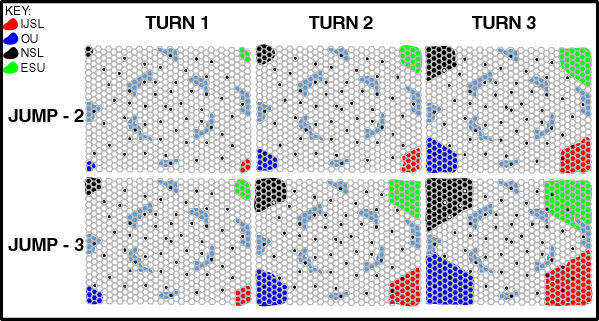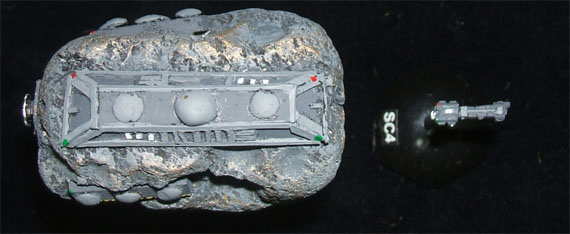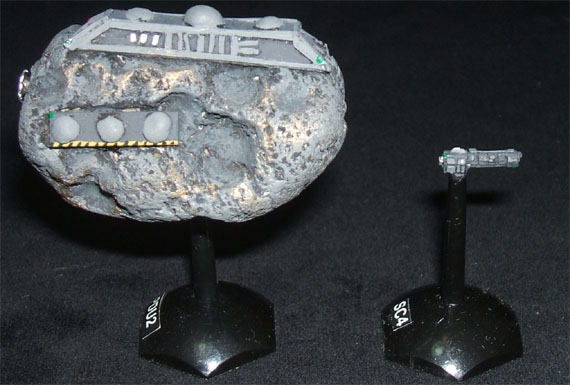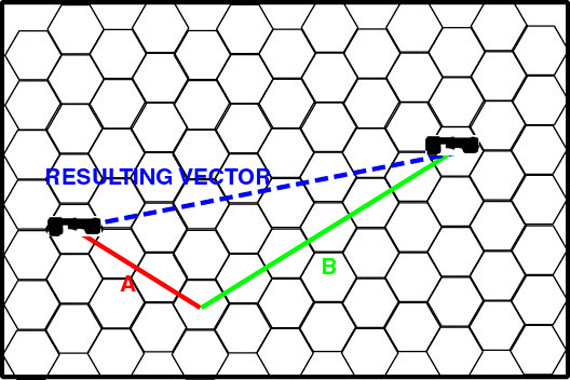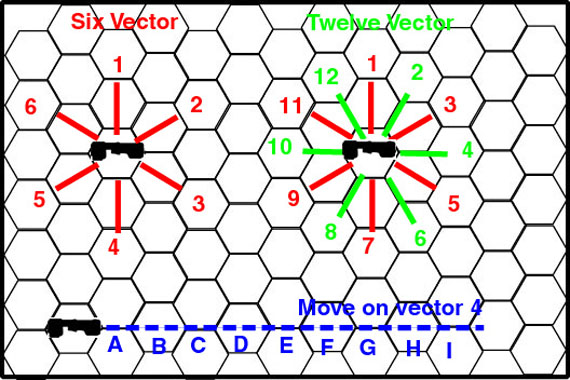
|
|||||||

|

Articles
Index
Game Start Analysis: Jump-2 or Jump-3?At game start, each empire was entitled to 2,000 Full Thrust Points worth of ships. In addition, 25 Industrial Points (IP) were available for use. These could be used to purchase more ships (At a conversion rate of 1 IP for 63 points worth of Full Thrust shipping. This would have been enough to purchase an extra 4 battleships!) or alternatively to purchase some starting technology. Inital jump technology available was Jump-2 (2 hexes move per turn). Several players opted to purchase Jump-3 technology. In games of this type, grabbing territory early on can be important. A quick analysis of the map given below reveals how many worlds were accessable in the first three turns of the game.
Empires with Jump-2 technology are severely hampered in their ability to find and colonise worlds. The information is presented in tabulated form below.
As can be seen at Jump-2 by the end of turn 3, most empires have access to only one world. The ESU would have access to none! As colonies have to be established by turn 4 to take advantage of the production round at the end of that turn, this is a problem. Not all worlds are equally useful, and establishing a colony on a sub-standard world can have further down-stream effects.
With access to Jump-3 technology, the empires have access to 3 or 4 pontential colony worlds by the end of turn 3. Is it worth passing up combat shipping at the beginning of the game in favour of more "legs"? Every player must decide for themselves.
Neu Swabian League Ship Painting GuideThe Neu Swabian League. Blunt, direct, brutal and very efficient. Under the Full Thust rules the NSL favours slow moving, heavily armoured ships, armed with lots of beam weapons. Even their heavy carrier - the Der Thueurdank - is so heavily armed and armoured that it can stand in the main line of battle. The models initially released by GZG for this range reinforce this image - oblong, slab sided, dense looking spaceships, squared off and looking as if they had been built up from modules bolted together.
So, in the words of the market researchers on the B-Ship in Hitchikers Guide to the Galaxy "OK then, if you are so smart,
what color do you think it should be?." After a moment's thought, there is only one colour really - grey. Having come
to a pocket universe, and faced with an at-the-throat struggle with the Eurasian Solar Union, and Kra'vak aliens, it seems
unlikely the NSL would spend a lot of time decorating their ships.
Far more likely is the possibility that the ships would be flung together in low planetary orbit, as quickly as possible,
by bolting together pre-assembled sections. So different shades of grey, resembling perhaps manufacturer's primer, with
different components coming from different factories - this seemed to be an appropriate theme. Given that engagements
occur in space at distances of millions of kilometers, and visual spotting wouldn't be very important, surface camoflage
seems unnecessary.
Initial assembly of the NSL ships involved weighting the base with a metal washer, araldyted in place, and the ship assembled onto the base by drilling and pinning the figure. Missiles are scratch built out of florists wire, and glued onto a hexagonal base made of clear plastic sheet (scavanged from shirt collar packagting). Colony ships are assembled from a ping pong ball and bits and bobs from a haberdashery shop. The fighter flights are likewise assembled onto a clear plastic hexagon (this is anchored to the base by a pin through the central fighter attached to the base). After assembly comes painting.
Next comes the old modellers stand-by: Paint from the inside out, and from darkest colour to lightest. So this suggested a simple method - black wash the ship, then paint the several superimposed layers of detail with ever lighter shades of grey, ending with the highest elements of relief being done in white. Add a few navigations lights in red and green, blue lights for carrier landing decks, silver engine nozzles, dry brushed bronze on the converted nickel-iron asteroids a few black-and-yellow hazard strips and voila!
Perhaps a note of clarification is useful here. In Stellar Conquest, it is possible to build Orbiting Planetary Defense Units (PDU's), and for fun I decided these would be manufactured by building them into captured nickel-iron asteroids (an idea that comes from from Traveller - the Buffered Planetoid).
The initial black washes were done with black acrylic paint bought from an art shop. The blue landing lights were painted in Resene acrylic Tory Blue (because it was readily on hand).
An NSL fleet assembled round a Der Thueurdank Attack Carrier, slips through the darkness of space...
Playing Full Thrust on Hexes
Hexes are great. They are the regular simple polygon with the largest number of faces. They are aesthetically pleasing and occur commonly in nature. They are useful for mapping. So it is inevitable that we should try and play Full Thrust on a hex field. The illustration above shows a table full of polystyrene hexagons with a pattern of one inch (25 mm) hexagons embossed on the surface. Bogey markers (made from ping pong balls) manouvre on the hex field.
Hexes are pretty. But they are also useful. Rather than measure ranges and movement with a tape measure, it is
possible to count hexes. On a wargaming table, there is sometimes some confusion as to the exact angle a ship
is pointing. On a hex field, with only six directions to point, there can be no confusion. Likewise the exact
position of a ship can be doubtful, leading to questionabe moves (known for historical reasons as a "surfboard").
This is avoided by using hexes - as there is no doubt as to the exact location of a vessel.
In one respect hexes "quantise" direction and distance.
Hexes have another advantage. It is easy to add vectors. A vector has two values - the bearing, and the distance.
By recording a vessel's vector in three directions on a hex field it is possible to keep exact record of the movement
of a vessel. In the diagram above, the vessel has a vector of 3 in direction A (red) and 7 in direction B (green).
The resulting vector is given (blue).
In Full Thrust ships can have twelve different headings. Using hexes, this can be achieved by using the six hex faces
and the six hex points. Six of the directions can be taken by travelling from hex to hex, through each hex face. The
other six directions can taken by moving from hex, across a point, along a hex edge, to the next hex. As long as a vessel
plotted with a vector from hex point to hex point has an even distance it will always end up in the middle of a hex.
In the diagram above, the ship is plotted to travel in direction 4 for a distance of 10.
In conclusion it is possible to model the motion of a space ship exactly in two dimensions using a hex field. By modelling
motion with six directions it requires recording the ships motion in three directions. By modelling motion in twelve
directions (standard Full Thrust) it requires recording the ships motion in six directions.
It is quite possible to do this. The question remains whether the extra paperwork is worth it.
Putting it all together, two NSL task forces engage each other in an exercise over Cephei I - the colony of Neu Konigsberg.
| Main | Events | Current | Battles | Rules | Articles | Links |
All images and designs copyright © 2002 - 2009 by Piraeus Games, Chris Harrod, David Billinghurst, John
Drummond, Eureka Miniatures and the owners of the respective sites mentioned on this page.
|
||||||||||||||||||||||||||||||||||||||||||||||||||||||||||||||||||||||||||||
| Page last modified on Sunday November 01 2009 02:17:00 |
